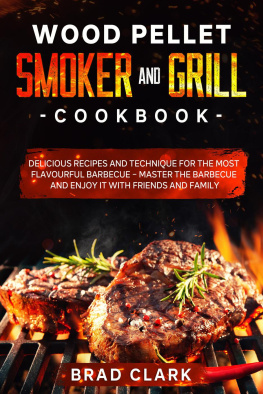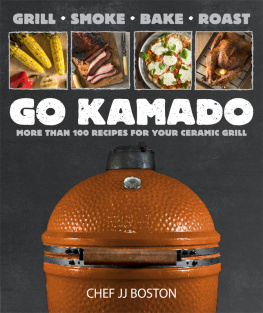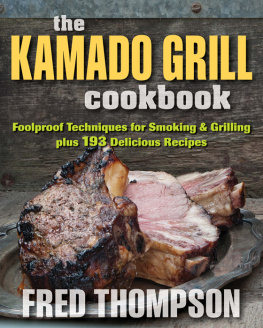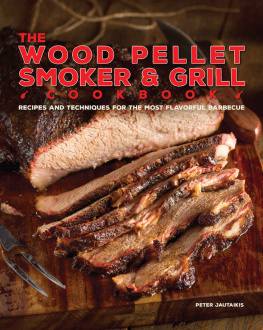
Text and photographs copyright 2015 Paul Sidoriak. Design and concept copyright 2015 Ulysses Press and its licensors. All rights reserved. Any unauthorized duplication in whole or in part or dissemination of this edition by any means (including but not limited to photocopying, electronic devices, digital versions, and the Internet) will be prosecuted to the fullest extent of the law.
Published by
Ulysses Press
P.O. Box 3440
Berkeley, CA 94703
www.ulyssespress.com
ISBN: 978-1-61243-508-4
Library of Congress Catalog Number 2015937545
Acquisitions editor: Kelly Reed
Managing editor: Claire Chun
Editor: Phyllis Elving
Proofreader: Lauren Harrison
Front cover design and interior design/layout:
Photographs: Paul Sidoriak except on Joe Strohmaier
Illustration : Suman Kasturia
Index: Sayre Van Young
IMPORTANT NOTE TO READERS: This book is independently authored and published and no sponsorship or endorsement of this book by, and no affiliation with, any trademarked brands of the kamado grill or other trademarked brands or products mentioned or pictured within is claimed or suggested. All trademarks that appear in this book belong to their respective owners and are used here for informational purposes only. The author and publisher encourage readers to patronize the quality brands and products pictured and mentioned in this book. Take special note of the important safety warnings throughout this book, and always use customary precautions for safe food preparation, handling, and storage.
To Chery, thank you for always being there to fuel my creativity.
CONTENTS
I have always enjoyed cooking, in one capacity or another. I think I started as a taste tester, shortly after I could hold a spoon without throwing it, and then worked my way up to helper. Some of my first chef duties came on special days such as Mothers Day, Fathers Day, or other occasions when our brigade agreed that a surprise or impromptu breakfast in bed for the parents was needed posthaste.
Looking back, I doubt if our domestic catering efforts were even edible, and some of my strongest memories are of the messes we made in the process. But we tried and were encouraged to try again. I always did my best to learn from the guests (my parents) reaction to early-morning smoke alarms, well-done (20-minute) eggs, and toast you could chip a tooth on. As time went on, the smoke detector remained silent, the kitchen stayed cleaner, and I kept expanding the quiver of dishes I could cook to perfection.
A few years ago, when I began cooking on the kamado grill, I felt the same excitement that Id had when cooking as a kid. Discovering the kamado was like cooking for 30 years and then discovering salt. The kamado adds so much flavor to dishes that it makes me want to cook better every time I fill my grill with charcoal.
Theres a funny thread that pops up now and again on Internet forums, about how owning a kamado will ruin you for going out to dinner at a restaurant. You see comments such as these:
Restaurants are falling short of expectations.
It was good, but I can cook flank steak 10 times better than what that chef was doing.
And my personal favorite: We wont go out very often now, but when we do Ill either order a) Something I know I dont want to make at home, or b) Something I want to make at home and am looking for some inspiration.
And its true. Kamado-grilled food often does taste better than what you get in a restaurant! Dining out becomes mere fodder to inspire new dishes at home, and reading the menu becomes an I can make that true-false quiz.
Cooking on the kamado grill has been a creative journey for me each step of the way. Starting out, I thought Id never grill a steak at anything under 700Funtil I learned just how quickly hair singes and knuckles burn. Smoking meat began innocently enough, and then one day I put so much hickory smoke into chicken thighs that the roof of my mouth itched when I bit into one. Even my passion project of pizzas yielded unsightly and inedible results at the beginning, with raw toppings and a crust that looked and tasted like charcoal. I guess you skin your knee along the way and learn from your mistakes on the grill. Ive done my best to learn from both my culinary successes and my failures, and I hope that my experience will help you make fewer mistakes and more fantastic dishes.
My personal zeal for creative cooking on the kamado grill has my head on a constant swivel looking for new and innovative ideas. The reward is watching a complete strangers reaction to my cooking. If someone takes a bite and looks confused, excited, inspired, and exhilarated all in the same breath, I know my food has created an emotion as well as an experience. When someone tells me theyd never have thought of cooking that on the grill, I know Ive done something right.
COOKING ON THE KAMADO
The kamado grill is one of the most versatileand addictivecooking devices you can own. Part of the mystique is that the cooking possibilities are seemingly endless. With a basic understanding of how the kamado operates, it becomes fun to challenge yourself to see just how creatively you can use it. Baking, braising, broiling, deep-frying, grilling, pan-frying, poaching, roasting, sauting, searing, stir-frying, and toasting are all methods available for tackling just about any culinary conundrum with your kamado.
Kamado grills are produced by a variety of manufacturers, but they all have certain features in common. The diagram below shows the kamados typical basic components.

The early kamado wasnt much more than a clay pot used as an refractory-style device to utilize fuel efficiently. Todays ceramic kamado is safer, easier to use, and far more efficient. Stronger handles and hinges are better-engineered to support the weight of the dome. Air circulates with greater efficiency across the coals and cooking surface, and the kamado has a tighter seal during cooking, thanks to high-temperature gaskets.
Similar to wood stoves, kamados all provide methods for controlling the airflow through the grill. Air is taken in toward the bottom of the cooker through the bottom vent and exhausted out of the grill through the top vent (cap-vent). Charcoal is ignited in a firebox toward the bottom of the cooker.
GETTING STARTED
Hardwood lump charcoal is whats almost exclusively used in kamado grills, partially because it produces less ash than engineered charcoal briquettes. It also produces a very efficient, even heat, adding an unmistakable barbecue flavor. Most manufacturers make their own version, which can be purchased where you bought your grill. National hardware chain stores carry brands like such as Cowboy Charcoal and Royal Oak for a reasonable price, but you often have to deal with massive amounts of dust and very small charcoal chunks in each bag.
At this time, my personal favorite charcoal is FOGO, because the lumps are always extremely large and you have almost no shard pieces or dusty waste. Just recently I tried Komodo Kamados extruded coconut charcoal made from coconut husks and tapioca starch. Unlike other brands, this charcoal comes in log-style pieces, about 11 inches long and 2 inches in diameter. These logs burn extremely consistently and add very little flavor to foodideal for a delicate fish or a dessert.

Next page









